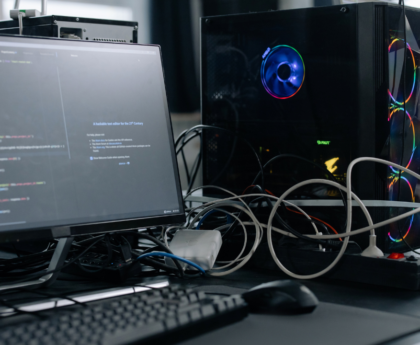The concept of the metaverse has captured the imaginations of technologists, entrepreneurs, and futurists alike. What began as a fictional world in science fiction novels is quickly becoming a reality, with companies investing billions in its development. By 2025, the metaverse will no longer be a distant concept but a part of our daily lives. This immersive digital world promises to revolutionize how we work, play, socialize, and interact with each other and the world around us. This article explores the evolution of the metaverse and what we can expect in 2025.
1. What is the Metaverse?
The metaverse is essentially a collective, virtual shared space that combines the physical world with digital elements in an immersive, interactive environment. It’s a virtual reality (VR) or augmented reality (AR)-enhanced universe where users can interact with one another and digital objects in real-time. Unlike isolated virtual experiences, the metaverse is a persistent, interconnected world with limitless possibilities.
Key characteristics of the metaverse include:
- Immersive Environments: Users can access fully immersive 3D worlds that blend the digital and physical spaces.
- Virtual Economy: Digital goods, services, and currencies exist within the metaverse, enabling transactions and economic activities.
- Interoperability: Different virtual worlds and platforms within the metaverse are connected, allowing for seamless transitions between them.
2. The Metaverse and the Future of Work
As remote work continues to grow, the metaverse is poised to change how we work, collaborate, and interact in professional environments. By 2025, many businesses will adopt the metaverse as a primary platform for meetings, events, and teamwork.
- Virtual Offices: Imagine logging into a virtual office space where your avatar can meet colleagues, attend meetings, and work collaboratively in real-time, all from the comfort of your home. This will make remote work feel more connected and interactive, removing the sense of isolation often associated with online work.
- Collaboration and Networking: Virtual spaces will allow employees to interact with colleagues, share ideas, and brainstorm in ways that are not possible in traditional video conferencing. 3D collaboration tools, virtual whiteboards, and shared digital workspaces will enhance the way teams collaborate and innovate.
- Skill Development and Training: The metaverse will also revolutionize corporate training. Companies will use immersive VR and AR simulations for hands-on training in fields like healthcare, engineering, and customer service, allowing employees to practice skills in a safe, controlled virtual environment.
3. The Metaverse in Entertainment and Gaming
Entertainment and gaming will be among the biggest drivers of the metaverse’s growth in 2025. The immersive nature of the metaverse offers unprecedented opportunities for gaming, storytelling, and interactive experiences.
- Immersive Gaming: In 2025, gamers will be able to step into vast, persistent virtual worlds that go far beyond traditional gaming. Through the use of VR headsets and advanced AI, the metaverse will deliver hyper-realistic, interactive experiences where players can explore, battle, and create together.
- Live Entertainment: The metaverse will host live concerts, theater performances, and sports events, where audiences can attend as avatars. Artists and performers will connect with global audiences in a new, immersive way, allowing fans to experience events from unique perspectives.
- Social Gaming: Games in the metaverse will become more social and community-driven, allowing players to engage with one another in real-time. Games like Fortnite, Roblox, and others are already laying the groundwork for metaverse-style gaming experiences, where players can build, interact, and create content.
4. The Metaverse Economy: Virtual Goods and Digital Currency
The economic aspect of the metaverse will be critical to its long-term success. In 2025, the metaverse will operate its own economy with virtual goods, services, and currencies.
- Digital Goods: Just like in the real world, the metaverse will have a thriving marketplace for virtual products. Users can buy virtual clothing, accessories for their avatars, and even virtual real estate. These digital assets will be tradeable, valuable, and collectible in their own right.
- Cryptocurrency and Blockchain: Cryptocurrencies, particularly those based on blockchain technology, will play a significant role in the metaverse economy. Digital currencies like Bitcoin and Ethereum will allow for secure transactions, while blockchain technology ensures transparency and ownership of virtual assets.
- Virtual Real Estate: Virtual land and properties within the metaverse will become valuable assets. Users can buy, sell, or rent virtual spaces for businesses, events, or socializing. Some companies are already developing virtual cities, where users can establish their presence and engage in commerce.
5. Social Interaction in the Metaverse
The metaverse will reshape the way we socialize and interact with others. It will provide new ways for people to connect, collaborate, and form relationships without geographical boundaries.
- Virtual Social Spaces: Users can gather in virtual lounges, parks, or cafes, engaging in conversations and activities with friends, family, and strangers. Whether it’s meeting for a virtual coffee, attending a concert, or going on a digital vacation, social interactions will feel more lifelike and meaningful.
- Enhanced Communication: The metaverse will allow for more nuanced and dynamic communication. Instead of being limited to text or video calls, users can interact using avatars and body language, making virtual interactions feel more like in-person experiences.
- Digital Identity and Personalization: In the metaverse, users will have the ability to craft their digital identities. Avatars can be customized in a variety of ways, allowing users to express themselves creatively. Additionally, personalized virtual environments will make users feel more at home in the digital world.
6. The Role of AR and VR in Shaping the Metaverse
Augmented Reality (AR) and Virtual Reality (VR) are the core technologies powering the metaverse. By 2025, we expect significant advancements in these technologies that will make digital experiences more immersive, realistic, and accessible.
- VR Headsets: VR headsets will become more affordable, comfortable, and advanced. With better motion tracking, higher-resolution displays, and improved user interfaces, VR will offer an even more immersive experience in the metaverse.
- AR Integration: AR will complement VR by blending digital content with the real world. Through AR glasses and mobile devices, users can overlay virtual objects onto the physical world, creating mixed-reality experiences. This will open up possibilities for everything from virtual meetings to interactive shopping experiences.
- Haptic Feedback: The development of haptic technology will provide users with tactile feedback, enhancing the realism of virtual interactions. Users will be able to “feel” objects and sensations within the metaverse, making the digital world even more immersive.
7. The Challenges of the Metaverse: Privacy, Security, and Accessibility
As the metaverse grows, it will face significant challenges that must be addressed to ensure its success and widespread adoption.
- Privacy Concerns: With users spending more time in the metaverse, there will be concerns about data privacy. Sensitive personal information, including biometric data, will need to be securely managed to prevent breaches and misuse.
- Security Risks: Just as with traditional digital platforms, the metaverse will be vulnerable to cyberattacks, hacking, and identity theft. Ensuring robust security systems will be essential to protect users and businesses.
- Accessibility: To make the metaverse inclusive, it must be accessible to people with disabilities. Developers will need to create virtual environments that accommodate different needs, including visual, auditory, and mobility impairments.
Conclusion: The Metaverse is Here to Stay
By 2025, the metaverse will no longer be a futuristic dream—it will be a tangible, immersive experience that transforms the way we work, play, and interact with one another. From virtual offices and immersive gaming to digital economies and social spaces, the metaverse will be a central part of our digital lives.
While there are challenges to overcome, the potential of the metaverse is immense. As technology continues to advance, the metaverse will become more accessible, realistic, and integrated into our everyday experiences. The future of digital interaction is here, and it is virtual.





